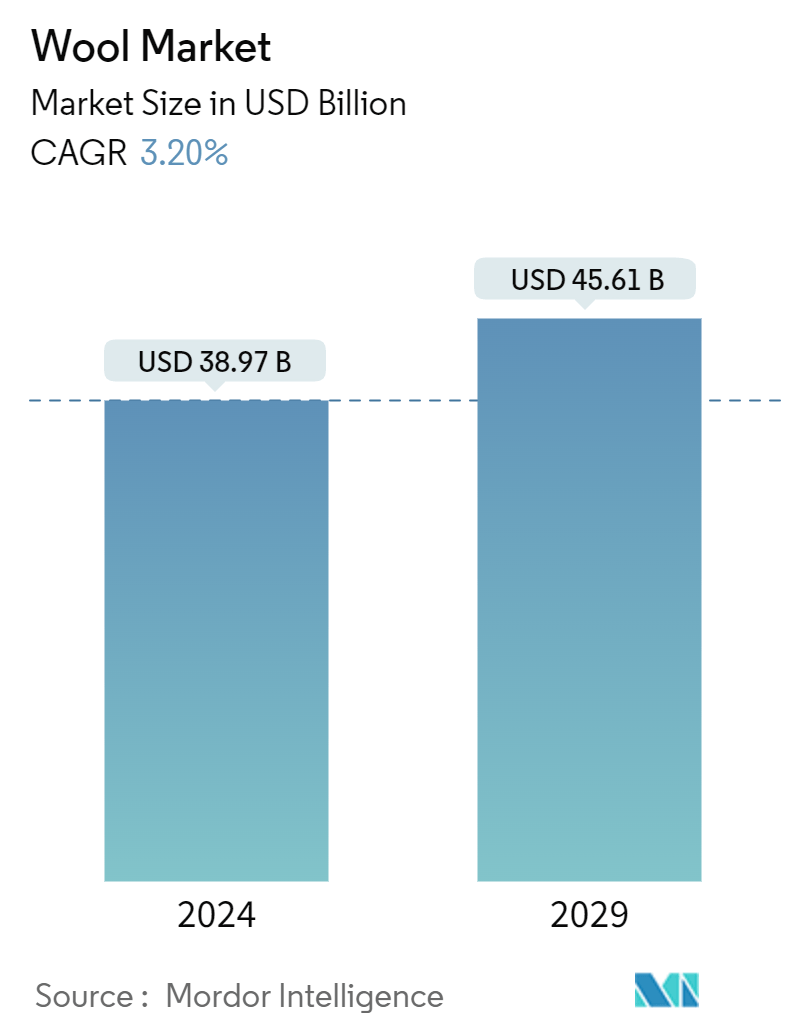Market Size of Wool Industry

| Study Period | 2019 - 2029 |
| Market Size (2024) | USD 38.97 Billion |
| Market Size (2029) | USD 45.61 Billion |
| CAGR (2024 - 2029) | 3.20 % |
| Fastest Growing Market | Europe |
| Largest Market | Asia-Pacific |
Major Players*Disclaimer: Major Players sorted in no particular order |
Wool Market Analysis
The Wool Market size is estimated at USD 38.97 billion in 2024, and is expected to reach USD 45.61 billion by 2029, growing at a CAGR of 3.20% during the forecast period (2024-2029).
Wool is an intricate natural fiber procured from the fleece of sheep. Wool sheep are classified as Ovis aries aries. Merino, Rambouillet, Blue-Faced Leicester, and Corriedale breeds are among the best-known wool sheep. There are projected to be more than 1,000 different breeds of sheep across the world. Wool is a versatile natural fiber and can be made into a wide range of woven or knitted fabrics. Depending on the length and fiber diameter (fineness) of fleece, it can be processed through either the woolen or worsted processing system. Worsted-spun knitted fabrics are super-soft, incredibly versatile knits for baby clothes, underwear, t-shirts and sportswear, leggings, dresses, and other lightweight knitwear.
With technological advancements in the wool manufacturing industry, there is a rapid development of spinning and weaving tools, which has led to increased sales of clothing across the world. For instance, in November 2022, Savio announced the launch of a new automatic winding machine, Proxima Smartconer, in the Indian market. Such innovations are projected to increase productivity. Over the long term, growth opportunities mainly lie with millennial consumers whose purchasing behavior, such as the preference for quality, authenticity, and transparency, is driving the wool market.
Various measures undertaken by the IWTO, a regulating authority for wool quality and traceability, are fetching higher prices for wool, thus encouraging production. According to the International Wool Textile Organization (IWTO), 50.0% of the weight of the wool is pure organic carbon. The factor driving the demand for wool is the increasing domestic consumption of luxury wool textiles in countries such as China, the United States, and Europe. Moreover, the biodegradable quality of wool is also supporting the market. Wool is a natural decomposer since it is biodegradable and provides less harm to the environment. In addition, wool has thermal insulation properties, making it suitable for consumers.
Wool Industry Segmentation
Wool is the textile fiber from sheep and other mammals, especially goats, rabbits, and camelids. The wool market is segmented by geography into North America, Europe, Asia-Pacific, South America, and Middle East and Africa. The report includes production analysis (volume), consumption analysis (value and volume), export analysis (value and volume), import analysis (value and volume), and price trend analysis. The report offers the market size and forecasts regarding volume (metric tons) and value (USD) for all the above segments.
| Geography (Production Analysis, Consumption Analysis by Value and Volume, Import Analysis by Value and Volume, Export Analysis by Value and Volume, and Price Trend Analysis) | ||||||||
| ||||||||
| ||||||||
| ||||||||
| ||||||||
|
Wool Market Size Summary
The wool market is poised for steady growth, driven by its versatility as a natural fiber and advancements in manufacturing technologies. Wool, sourced from various sheep breeds such as Merino and Rambouillet, is processed into a wide range of fabrics, from super-soft knits for clothing to coarser materials for carpets and furnishings. The industry's expansion is supported by innovations in spinning and weaving tools, which enhance productivity and cater to the evolving consumer preferences for quality and sustainability. Regulatory bodies like the International Wool Textile Organization (IWTO) play a crucial role in maintaining wool quality and traceability, thereby boosting consumer confidence and encouraging production. The biodegradable and thermal insulation properties of wool further bolster its demand, particularly in luxury textile markets across regions like China, the United States, and Europe.
The global wool market is characterized by significant trade activities, with major producers such as Australia, China, and New Zealand leading in production and exports. Australia, in particular, stands out as the largest wool export nation, with its fine Merino wool being highly sought after in the fashion industry. The market's diversity is reflected in the wide range of applications for wool, from high-end fashion to eco-friendly apparel, aligning with the growing consumer demand for sustainable and biodegradable products. Initiatives like the National Wool Declaration Integrity Program enhance transparency and quality assurance, further supporting market growth. As the market continues to evolve, the increasing sheep population and institutional efforts to ensure quality are expected to drive wool production and consumption, particularly in the Asia-Pacific region.
Wool Market Size - Table of Contents
-
1. MARKET DYNAMICS
-
1.1 Market Overview
-
1.2 Market Drivers
-
1.3 Market Restraints
-
1.4 Value Chain Analysis
-
-
2. MARKET SEGMENTATION
-
2.1 Geography (Production Analysis, Consumption Analysis by Value and Volume, Import Analysis by Value and Volume, Export Analysis by Value and Volume, and Price Trend Analysis)
-
2.1.1 North America
-
2.1.1.1 United States
-
2.1.1.2 Mexico
-
-
2.1.2 Europe
-
2.1.2.1 Germany
-
2.1.2.2 Belgium
-
2.1.2.3 United Kingdom
-
2.1.2.4 Italy
-
2.1.2.5 Netherlands
-
2.1.2.6 Turkey
-
-
2.1.3 Asia-Pacific
-
2.1.3.1 China
-
2.1.3.2 India
-
2.1.3.3 Japan
-
2.1.3.4 Australia
-
2.1.3.5 New Zealand
-
-
2.1.4 South America
-
2.1.4.1 Brazil
-
2.1.4.2 Argentina
-
-
2.1.5 Middle East and Africa
-
2.1.5.1 UAE
-
2.1.5.2 Saudi Arabia
-
2.1.5.3 Oman
-
2.1.5.4 Morocco
-
-
-
Wool Market Size FAQs
How big is the Wool Market?
The Wool Market size is expected to reach USD 38.97 billion in 2024 and grow at a CAGR of 3.20% to reach USD 45.61 billion by 2029.
What is the current Wool Market size?
In 2024, the Wool Market size is expected to reach USD 38.97 billion.

